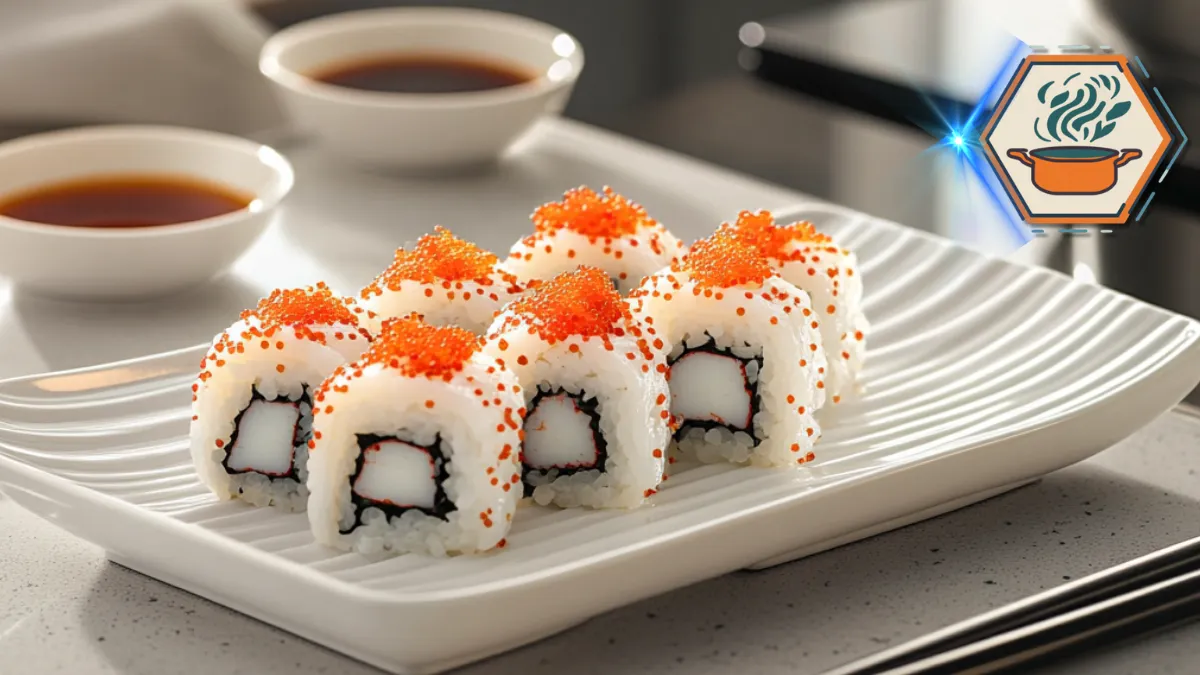Time to read:11 minutes
Table of Contents
Introduction to Tobiko
Tobiko fish roe, known for its vibrant colors and crunchy texture, is a prized ingredient in Japanese cuisine. Derived from flying fish, these small, flavorful eggs enhance dishes like sushi and sashimi with their unique taste. The versatility of tobiko fish roe makes it a staple for chefs worldwide.
1.1 What Is Tobiko?
Tobiko describes the roe of flying fish, known for its bright appearance and subtle smoky flavor. These eggs, which measure about 0.5 to 0.8 millimeters, naturally come in orange but are often infused with natural dyes or flavors. For example, wasabi creates a green variety, while squid ink produces black tobiko.
Chefs frequently use tobiko as a sushi garnish or as a filling for specialty rolls. Its slightly sweet and salty profile, combined with its crunchy texture, adds depth to many dishes. Additionally, its small size ensures it blends seamlessly into various recipes.
- Explore how tobiko can elevate your dishes with our tobiko guide for fish roe.
1.2 The Origins of Tobiko
Japan introduced tobiko to the culinary world, highlighting its role in traditional cuisine. Flying fish, found in tropical and subtropical waters, produce these eggs. While many countries now harvest and use tobiko, its strong association with Japanese dishes remains undeniable.
Japanese chefs have relied on tobiko for centuries to enhance sushi and sashimi. It brings both color and flavor to the table, making it a versatile ingredient. Furthermore, its affordability compared to other roes, like ikura, contributes to its widespread use.
- For a comprehensive overview of Japanese cuisine, including its history, ingredients, and cultural significance, consider exploring the Japan National Tourism Organization’s page on Japanese Cuisine. This resource provides detailed insights into the evolution and characteristics of Japanese culinary traditions.
1.3 Differences Between Tobiko, Masago, and Ikura
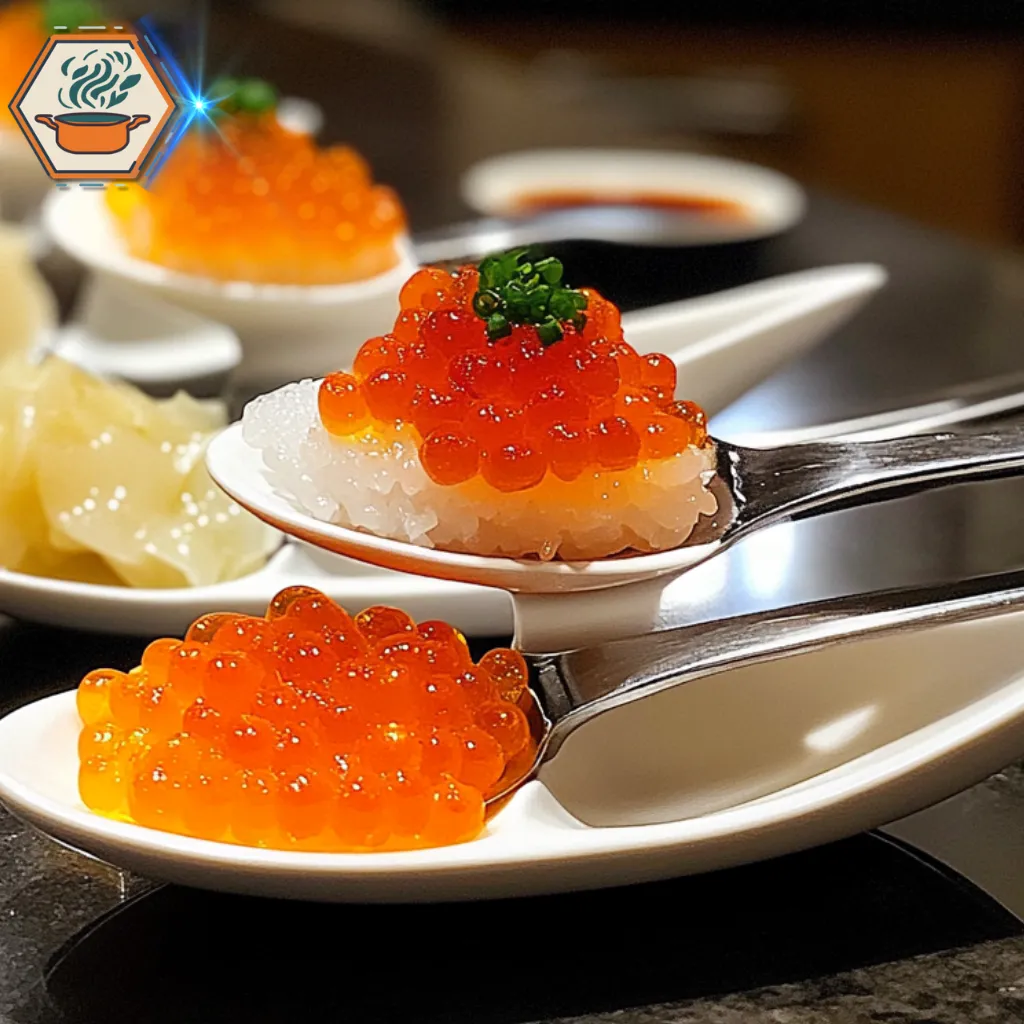
Although tobiko, masago, and ikura belong to the same category of fish roe, they have unique characteristics:
- Tobiko: Derived from flying fish, it offers a crunchy texture and vibrant color.
- Masago: Harvested from capelin fish, it has a finer texture and a more subdued flavor.
- Ikura: Taken from salmon, it features large eggs with a rich, briny taste.
Among these, tobiko remains a popular choice for its balance of texture, flavor, and cost. While masago serves as a more affordable option, it lacks the distinctive crunch of tobiko. On the other hand, ikura’s richness makes it ideal for premium dishes.
1.4 Common Colors and Flavors of Tobiko
Tobiko is famous for its bright colors, which are often enhanced with natural ingredients:
- Orange (Natural): The most common form, offering a balanced sweet and salty taste.
- Black (Squid Ink): Adds a smoky flavor and creates dramatic visual contrast.
- Green (Wasabi): Provides a spicy kick that pairs well with sushi.
- Red (Chili): Infused with chili for a mild heat and bold color.
- Yellow (Yuzu): Features a citrusy flavor that complements fresh dishes.
These variations allow chefs to experiment with flavors and presentation. For instance, black tobiko can contrast with white rice, while yuzu tobiko pairs well with seafood salads. The versatility of tobiko ensures it remains a favorite in kitchens worldwide.
Culinary Uses of Tobiko Fish Roe
Tobiko fish roe is a versatile ingredient known for its vibrant color and crunchy texture. Widely used in Japanese cuisine, it adds a unique touch to dishes and appeals to food enthusiasts worldwide. This section explores its culinary applications in detail, including its role in sushi, creative pairings, and innovative dishes.
Tobiko in Japanese Cuisine
Tobiko fish roe is deeply rooted in Japanese culinary traditions, celebrated not only for its vibrant appearance but also for its unique texture and flavor. This versatile ingredient elevates a wide range of dishes, adding a burst of briny goodness and a touch of sophistication. Its role extends beyond sushi and sashimi, showcasing its adaptability in Japanese cooking.
Sushi and Sashimi
Tobiko is most famously associated with sushi and sashimi, where it serves as both a flavorful and decorative element.
- Makizushi (Rolled Sushi): Tobiko is commonly used as a topping for inside-out rolls (uramaki), such as California rolls, where it coats the rice exterior, adding a pop of color and crunch.
- Nigiri Sushi: It is also layered atop hand-pressed rice, sometimes accompanied by a quail egg for an indulgent touch.
- Sashimi Garnish: In sashimi presentations, tobiko is placed delicately alongside fresh fish slices, enhancing the dish’s overall appeal and providing an extra layer of umami.
Donburi Dishes
In Japanese rice bowls, or donburi, tobiko plays a starring role in creating both flavor and texture contrasts.
- Seafood Donburi: Tobiko is often added to seafood rice bowls alongside salmon, tuna, or scallops, enhancing the oceanic flavors of the dish.
- Fusion Donburi: For a modern twist, tobiko pairs well with creamy sauces or spicy mayo, offering an exciting variation on traditional flavors.
Miso Soups
A small spoonful of tobiko can dramatically elevate a simple bowl of miso soup.
- Flavor Enhancement: The slight sweetness and saltiness of tobiko balance the umami-rich miso broth.
- Visual Appeal: The roe’s bright colors create a striking contrast against the soup’s muted tones, making the dish more appetizing.
Beyond the Basics: Tobiko in Japanese Sauces and Garnishes
- Creamy Tobiko Sauce: Tobiko is frequently mixed into mayonnaise or sour cream to create a rich, flavorful sauce for drizzling over sushi rolls, tempura, or grilled seafood.
- Garnishes for Hot Dishes: Tobiko is sprinkled over warm dishes like tamagoyaki (Japanese rolled omelet) or steamed vegetables, adding crunch and a hint of saltiness.
- Cold Appetizers: When paired with chilled tofu or soba noodles, tobiko adds a burst of flavor and a luxurious texture.
Modern Japanese Tobiko Creations
In contemporary Japanese cuisine, chefs are experimenting with tobiko in creative ways:
- Tobiko-Topped Tempura: Lightly fried tempura pieces are garnished with tobiko for an added layer of texture and flavor.
- Tobiko Rice Balls (Onigiri): Tobiko is mixed with steamed rice and wrapped in nori for a savory snack.
Tobiko fish roe continues to be a versatile and essential ingredient in Japanese cuisine, blending seamlessly with traditional dishes while inspiring innovative culinary creations. Its ability to enhance both taste and presentation makes it a cherished addition to kitchens and menus worldwide.
For more insights on Japanese cooking techniques, check this What is sushi cake made of?
Tobiko as a Sushi Topping
Tobiko fish roe is a popular sushi topping because of its vibrant appearance and subtle briny taste. It’s commonly seen in maki rolls and nigiri, where it complements other seafood ingredients.
Common Ways Tobiko is Used in Sushi
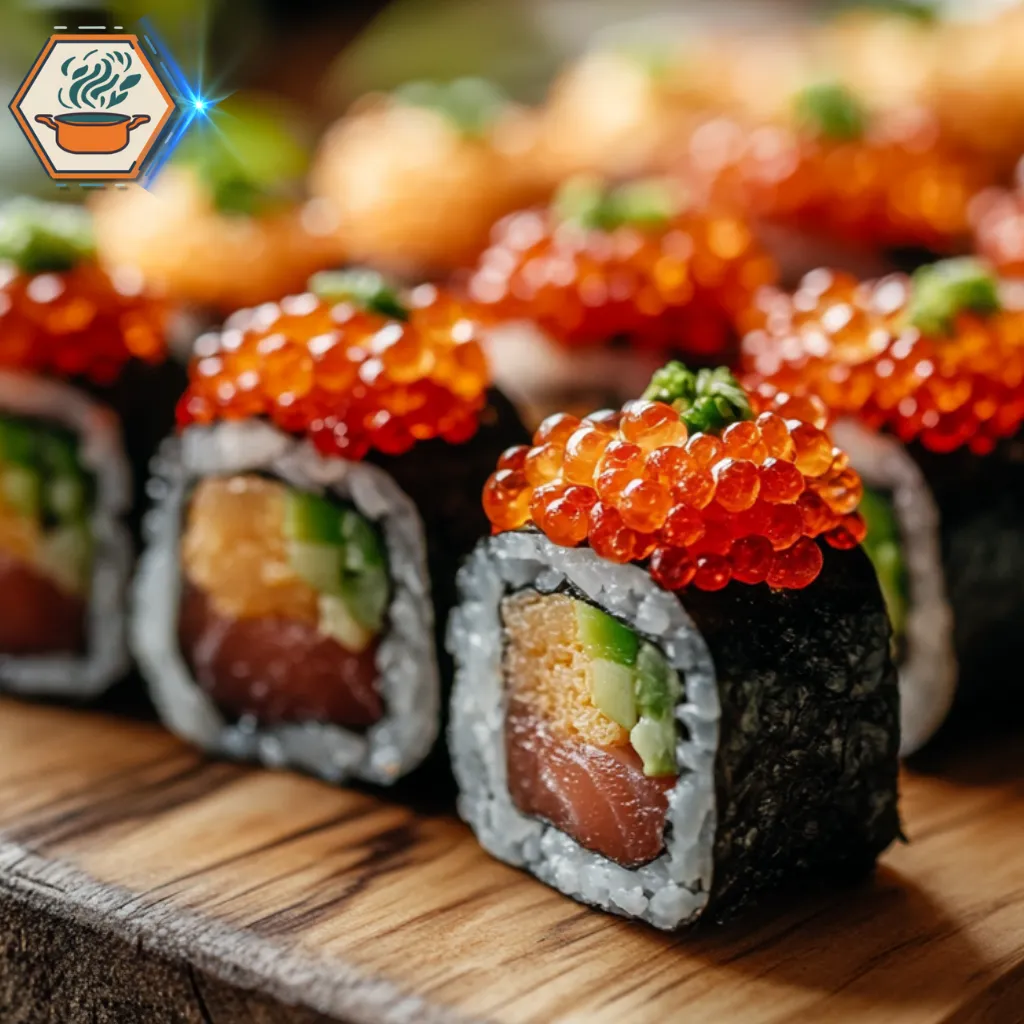
- California rolls: A classic example where tobiko coats the outer layer of the roll.
- Gunkan-maki: Tobiko is placed atop rice and wrapped in seaweed, creating a boat-shaped sushi piece.
- Inside-out rolls: Tobiko is sprinkled over rice to add color and flavor.
For a creative twist, tobiko is sometimes infused with flavors like yuzu or wasabi to enhance its profile.
Why Tobiko is Essential for Sushi Enthusiasts
- Provides an extra layer of texture.
- Adds a pop of color, making dishes visually appealing.
- Offers a subtle umami flavor that enhances other ingredients.
Explore more about What does a tempura roll have in it? for pairing ideas.
Pairing Tobiko with Other Ingredients
Tobiko’s versatility allows it to pair well with a variety of foods, from traditional Japanese elements to international cuisines.
- Seafood combinations: Pairing tobiko with shrimp, crab, or scallops enhances the dish’s oceanic flavors.
- Creamy bases: Tobiko’s crunch contrasts beautifully with creamy ingredients like avocado, mayonnaise, or cream cheese.
- Vegetables: Cucumbers and carrots provide a refreshing crunch that complements tobiko.
Unique Dishes Featuring Tobiko
Tobiko has inspired chefs to create innovative dishes that go beyond traditional uses. Here are a few standout ideas:
- Tobiko-topped pasta: A fusion dish combining creamy pasta with the briny taste of tobiko.
- Tobiko-stuffed dumplings: Adds a surprising crunch to every bite.
- Tobiko tacos: Incorporates the fish roe into spicy, tangy taco fillings.
- Tobiko caviar tartlets: Elegant appetizers featuring tobiko as the star ingredient.
Nutritional Information and Health Benefits of Tobiko Fish Roe
Tobiko fish roe is not only a culinary delight but also a nutritious ingredient enjoyed worldwide. These tiny, flavorful eggs are rich in nutrients, making them a great addition to your diet. This section explores their caloric and macronutrient profile, the health benefits they provide, potential concerns, and how they fit into a balanced diet.
3.1 Caloric and Macronutrient Profile
Tobiko fish roe is low in calories and packed with essential nutrients, making it a great option for those who want flavorful yet healthy meals. Here is an overview of its key nutritional components:
- Calories: On average, a tablespoon of tobiko contains about 30-40 calories. This makes it a low-calorie topping for sushi and other dishes.
- Protein: Tobiko is a protein-rich food, offering approximately 3 grams of protein per tablespoon. This makes it ideal for muscle repair and growth.
- Fat: With only 1 gram of fat per serving, tobiko is low in unhealthy fats. Most of the fat it contains is omega-3 fatty acids.
- Carbohydrates: Tobiko is virtually free of carbs, making it suitable for low-carb and keto diets.
- Micronutrients: It is a good source of vitamins B12, D, and E, as well as minerals like selenium, zinc, and iodine.
Including tobiko in your meals can help you meet daily nutrient requirements without adding excessive calories.
3.2 Health Benefits of Eating Tobiko
Adding tobiko fish roe to your diet comes with several health advantages. Below are the main benefits:
1. Rich in Omega-3 Fatty Acids
Omega-3 fatty acids are essential for heart and brain health. Tobiko contains these healthy fats, which help:
- Lower cholesterol levels.
- Reduce inflammation in the body.
- Support cognitive function and mental well-being.
2. Boosts Immune Function
The high selenium content in tobiko helps strengthen the immune system. Selenium functions as a powerful antioxidant, helping to safeguard cells from damage caused by free radicals.
3. Promotes Healthy Skin and Hair
Tobiko’s vitamin E content supports skin elasticity and hair strength. The antioxidants in this vitamin combat aging and improve skin tone.
4. Improves Energy Levels
Vitamin B12 in tobiko is crucial for energy production and proper nerve function. It also helps prevent anemia by supporting red blood cell formation.
5. Supports Bone Health
The vitamin D in tobiko plays a vital role in calcium absorption, which is essential for maintaining strong bones and teeth.
3.3 Potential Concerns or Risks
While tobiko fish roe offers many health benefits, there are a few considerations to keep in mind:
1. High Sodium Content
Tobiko is often cured with salt to enhance its flavor and preserve freshness. This means it can contain high levels of sodium. Overconsumption may lead to:
- Increased blood pressure.
- Water retention.
2. Allergy Risk
Some individuals may be allergic to fish roe. Symptoms include:
- Skin rashes.
- Difficulty breathing.
- Stomach upset.
3. Environmental Concerns
Sourcing tobiko sustainably is crucial to avoid contributing to overfishing and environmental harm. Look for ethically sourced products.
4. Pregnancy Caution
Pregnant individuals should consume tobiko in moderation due to its sodium content and the potential for contamination with harmful bacteria if improperly stored.
3.4 Tobiko in a Balanced Diet
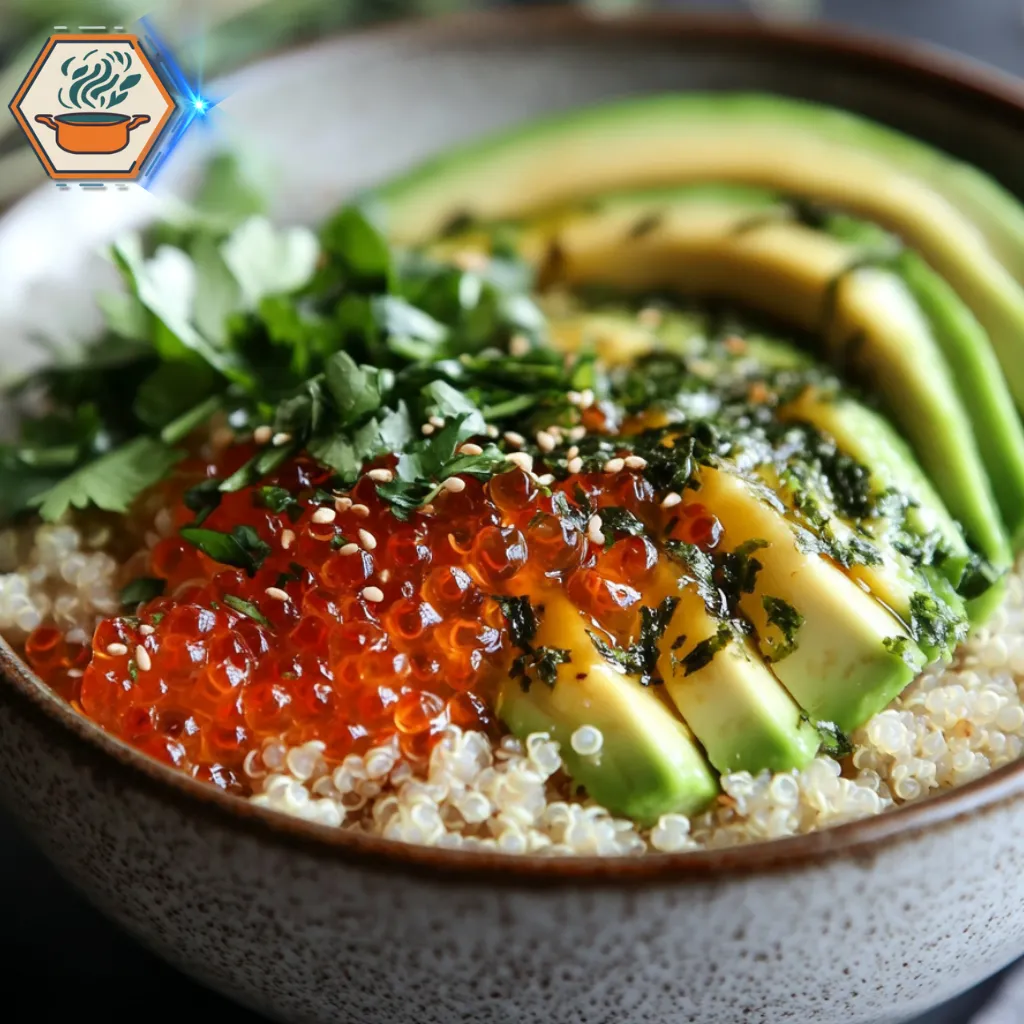
Tobiko fish roe can be a valuable part of a balanced diet. Here are some tips to incorporate it healthily:
- Pair with Vegetables: Add tobiko to salads or vegetable-based sushi rolls for a nutrient boost.
- Serve in Moderation: Due to its high sodium content, limit servings to 1-2 tablespoons per meal.
- Combine with Whole Grains: Use tobiko as a topping for brown rice or quinoa bowls to create a satisfying and nutritious dish.
- Include Healthy Fats: Pair with avocado or olive oil-based dressings to complement the omega-3s in tobiko.
Recipe Ideas:
- Sprinkle Tobiko Fish Roe on Cucumber Slices: Create an elegant and quick appetizer by layering thinly sliced cucumbers with a dollop of cream cheese and a generous sprinkle of tobiko fish roe. This combination offers a refreshing crunch with a savory burst of flavor, perfect for entertaining or a light snack.
- Top Scrambled Eggs or Omelets with Tobiko Fish Roe: Enhance your breakfast by adding tobiko fish roe to freshly scrambled eggs or folded omelets. The roe’s briny crunch complements the creamy texture of eggs, making it a delightful and nutrient-rich start to your day.
- Tobiko Avocado Toast: Spread mashed avocado on whole-grain toast, then top with a sprinkle of tobiko fish roe. The creamy avocado pairs beautifully with the roe’s slight saltiness, creating a balanced and Instagram-worthy dish.
- Tobiko Sushi Bowls: Assemble a sushi-inspired bowl with sushi rice, sliced vegetables, and your choice of protein like crab or shrimp. Finish with a generous topping of tobiko fish roe for added texture and a pop of vibrant color.
- Tobiko Pasta Delight: Mix tobiko fish roe into a creamy pasta sauce, adding a subtle briny flavor and a unique texture. Pair with spaghetti or linguine and garnish with fresh parsley or chives for a restaurant-quality dish.
- Tobiko Salad Garnish: Toss a light green salad with a citrusy dressing and sprinkle tobiko fish roe over the top. This adds both visual appeal and a deliciously crunchy, salty note to your healthy meal.
- Tobiko-Topped Sushi Rolls: Enhance your homemade sushi rolls by layering tobiko fish roe on the outside of rice-wrapped rolls. The roe adds an authentic touch and amplifies the umami flavor of your sushi.
- These creative ideas showcase how tobiko fish roe can transform simple dishes into culinary masterpieces, offering versatility and sophistication to your meals.
Master Caramelizing Sugar for a delicious dessert to pair with your tobiko-inspired meals.
Tobiko Storage and Buying Tips
Tobiko fish roe is a versatile and flavorful ingredient in Japanese cuisine. To enjoy it fully, you need to know how to store it, identify quality, and find the best buying options. Let’s dive into these essential tips to ensure your tobiko experience is always top-notch.
Tobiko Alternatives for Cooking
If tobiko isn’t available, there are several alternatives to consider. These substitutes replicate its unique qualities in different ways:
- Masago (Capelin Roe): Smaller and less crunchy than tobiko but offers a similar mild taste. It’s often more affordable and widely available.
- Ikura (Salmon Roe): Larger and juicier than tobiko, with a stronger flavor. Ideal for bold dishes.
- Caviar: Premium-quality caviar can serve as an upscale alternative, though it’s less briny and more buttery in taste.
Quick Comparison: Tobiko vs. Masago
| Feature | Tobiko | Masago |
|---|---|---|
| Size | Larger | Smaller |
| Texture | Crunchy | Softer |
| Price | Moderately priced | More affordable |
How to Store Tobiko for Freshness
Proper storage of tobiko fish roe is key to maintaining its taste and texture. Tobiko is perishable, so following these guidelines will help:
- Refrigerate Immediately: Keep tobiko refrigerated at 32°F to 39°F (0°C to 4°C). Always store it in an airtight container to prevent exposure to air and odors from other foods.
- Freeze for Longevity: If you’re not using tobiko within a week, freezing is an excellent option. Wrap it tightly in plastic wrap or vacuum-seal it, then place it in a freezer-safe bag or container. This helps preserve its flavor for up to three months.
- Defrosting Tips: When ready to use, defrost tobiko slowly in the refrigerator overnight. Avoid thawing at room temperature to prevent spoilage.
Quick Checklist for Tobiko Storage
- Use airtight containers
- Refrigerate promptly
- Freeze if storing for over a week
- Defrost in the fridge only
Learn more about the Bone Broth Cooking and Storage Guide to pair tobiko with warm broths in unique recipes.
How to Identify Quality Tobiko
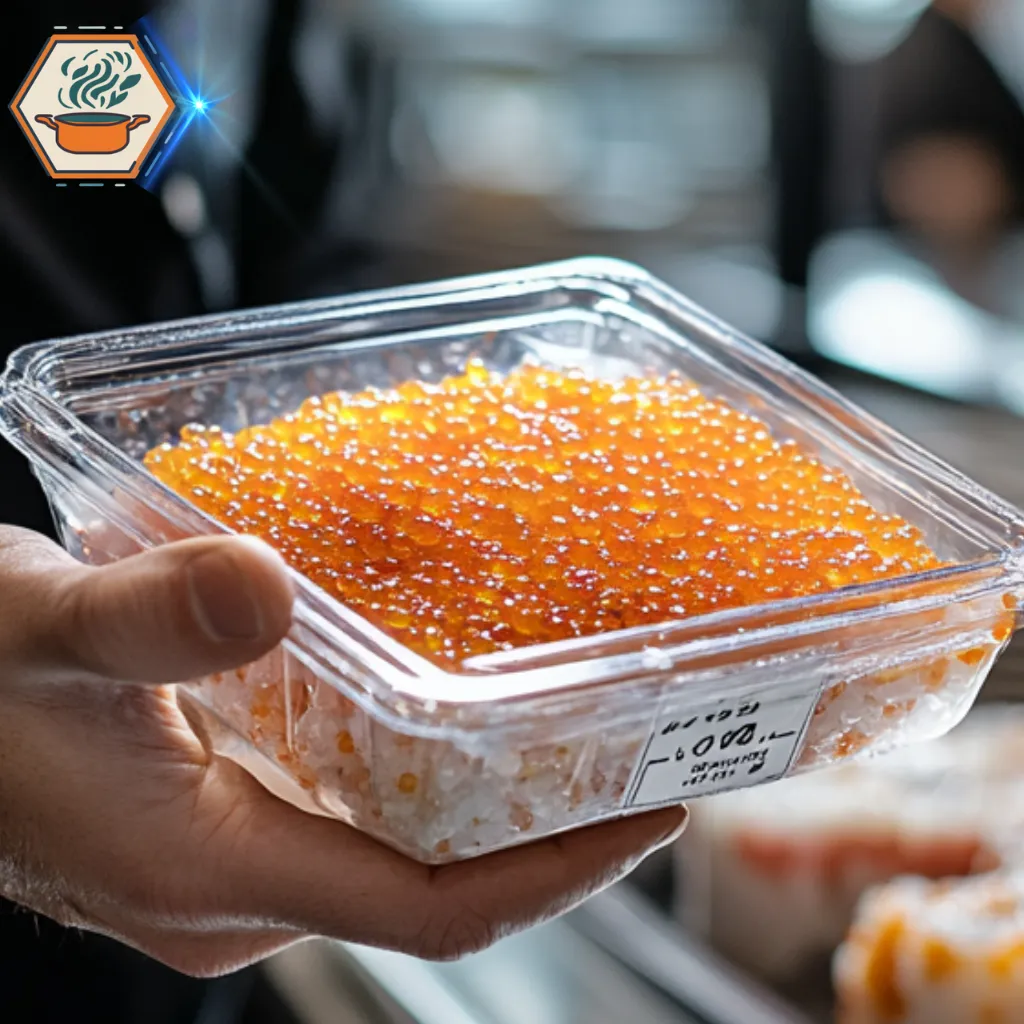
Choosing high-quality tobiko fish roe ensures a better culinary experience. Follow these tips to identify the best tobiko:
- Color Consistency: Fresh tobiko has vibrant colors such as orange, red, black, or green, depending on flavor additions. The color should look natural and not overly artificial.
- Texture: Tobiko should feel firm and slightly crunchy. Avoid overly mushy or dry textures, which can indicate poor handling.
- Smell: Fresh tobiko has a mild, briny aroma. If it smells overly fishy or unpleasant, it may not be fresh.
- Packaging: When buying pre-packaged tobiko, ensure the container is sealed and shows no signs of damage. Look for products labeled with clear expiration dates.
Red Flags for Low-Quality Tobiko
- Discolored or uneven hues
- Strong, off-putting odors
- Excessive liquid in the packaging
- Expired or missing date labels
Best Places to Buy Tobiko
Finding reliable sources for tobiko can make all the difference. Here are some top places to purchase:
- Japanese Grocery Stores: Specialty Asian markets often have a wide selection of tobiko in various flavors.
- Online Retailers: Trusted online platforms offer fresh tobiko delivered directly to your door. Ensure the seller uses proper refrigeration and shipping methods.
- Seafood Markets: Local seafood vendors often carry high-quality tobiko. They can also provide insights on freshness and sourcing.
Tips for Buying Tobiko Online
- Check customer reviews
- Verify refrigeration methods during shipping
- Look for sellers with high ratings for freshness
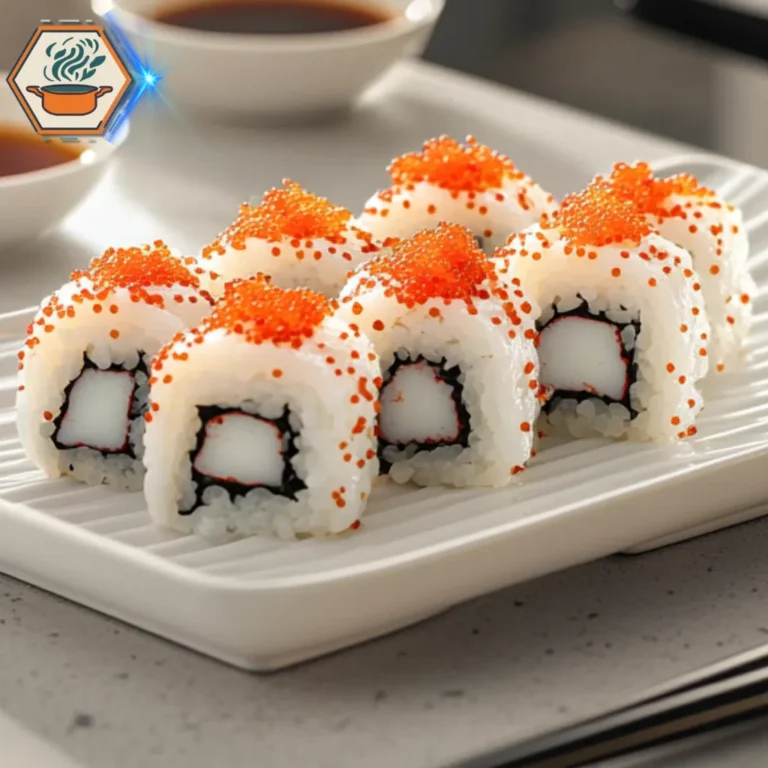
What is tobiko?Exploring Tobiko Fish Roe: A Culinary Delight
Tobiko fish roe enhances sushi, sashimi, and various dishes with its vibrant colors, crunchy texture, and unique flavors, offering culinary sophistication.
- Total Time: 10 minutes
Ingredients
Tobiko doesn’t have a conventional “recipe,” but here’s a breakdown of ingredients commonly paired with it for various dishes:
- Tobiko (Flying Fish Roe) – 2 tablespoons
- Sushi Rice – 1 cup (cooked)
- Nori Sheets – 2 sheets (optional for sushi rolls)
- Avocado – 1/2 (sliced)
- Cucumber – Thinly sliced
- Soy Sauce – 1 tablespoon (for serving)
- Wasabi Paste – 1 teaspoon (optional)
- Cream Cheese – 1 tablespoon (for creamy pairings)
- Mayonnaise – 2 tablespoons (for tobiko sauce)
- Cooked Shrimp or Crab – 1/2 cup (for toppings)
- Quail Egg – 1 (optional garnish)
- Fresh Herbs – 1 teaspoon (parsley, chives, or microgreens for garnish)
Instructions
For Sushi Rolls:
- Lay out a sheet of nori on a bamboo mat.
- Spread a thin layer of cooked sushi rice evenly over the nori.
- Sprinkle tobiko over the rice for a vibrant touch.
- Add sliced avocado, cucumber, and cooked shrimp.
- Roll the sushi tightly and slice into bite-sized pieces.
For Garnishes or Toppings:
- Sprinkle tobiko over cucumber slices, scrambled eggs, or creamy avocado toast.
- Mix with mayonnaise to create a creamy tobiko sauce. Drizzle over grilled seafood or sushi rolls.
For Pasta:
- Cook pasta of your choice (e.g., spaghetti or linguine).
- Prepare a creamy sauce by blending heavy cream, butter, and garlic.
- Stir in tobiko for a briny, crunchy finish.
Notes
- Storage: Store tobiko in an airtight container in the refrigerator for up to 1 week. For longer storage, freeze for up to 3 months.
- Substitutions: Use masago (capelin roe) or ikura (salmon roe) if tobiko is unavailable.
- Pairing Tips: Tobiko pairs well with seafood, creamy bases like avocado or mayonnaise, and lightly seasoned vegetables.
- Prep Time: 10 minutes
- Cook Time: N/A (most tobiko-based dishes are raw or involve minimal preparation)
- Category: Appetizer, Snack, Main Course
- Cuisine: Japanese Fusion
FAQs
1. What is tobiko fish roe?
Tobiko fish roe refers to the small, crunchy eggs of flying fish, commonly used in Japanese cuisine. Known for their vibrant colors and subtle smoky flavor, tobiko enhances dishes like sushi, sashimi, and rice bowls.
2. How is tobiko fish roe different from masago and ikura?
Tobiko is larger than masago (capelin roe) and smaller than ikura (salmon roe). It offers a crunchy texture, while masago is finer and ikura is juicier with a rich, briny flavor.
3. What are the common uses of tobiko fish roe in cooking?
Tobiko is most often used as a topping for sushi rolls, sashimi, and gunkan-maki. It can also be added to sauces, salads, rice bowls, and even pasta dishes for a burst of flavor and color.
4. What flavors and colors are available for tobiko fish roe?
Tobiko comes in various flavors and colors, including natural orange, wasabi-infused green, squid ink black, chili red, and citrusy yuzu yellow. Each variation provides a unique flavor and visual appeal.
5. Is tobiko fish roe healthy?
Yes, tobiko fish roe is rich in protein, omega-3 fatty acids, and essential vitamins like B12, D, and E. However, it is high in sodium, so it should be consumed in moderation.
6. Can tobiko fish roe be eaten raw?
Yes, tobiko is typically cured and can be safely eaten raw. It is commonly served on sushi, sashimi, or as a garnish for various dishes.
7. How should tobiko fish roe be stored?
Tobiko should be refrigerated in an airtight container and consumed within a week. For longer storage, it can be frozen for up to three months and thawed in the refrigerator when needed.
8. Can I use tobiko fish roe in non-Japanese dishes?
Absolutely! Tobiko can be incorporated into pasta, tacos, canapés, or even as a topping for scrambled eggs or avocado toast, adding a touch of sophistication and flavor.
9. Where can I buy tobiko fish roe?
Tobiko is available at Japanese grocery stores, specialty seafood markets, and online retailers. Ensure it is fresh by checking for vibrant colors, a firm texture, and a mild briny aroma.
10. Is tobiko fish roe sustainable?
The sustainability of tobiko depends on sourcing practices. Look for products labeled as ethically harvested or certified sustainable to minimize environmental impact.
11. Can tobiko fish roe be used in vegetarian or vegan recipes?
Tobiko is not suitable for vegetarian or vegan diets as it is derived from fish. However, vegan alternatives made from seaweed or other plant-based ingredients are available.

